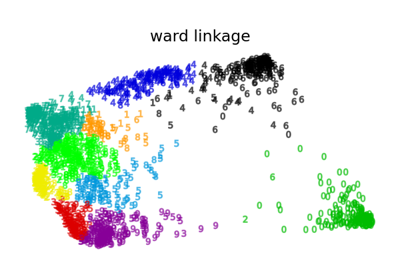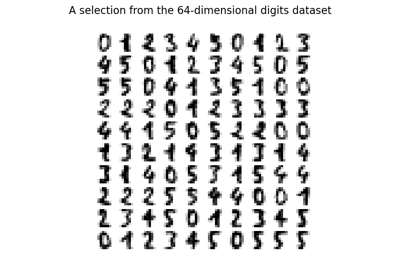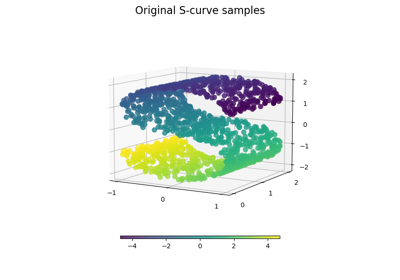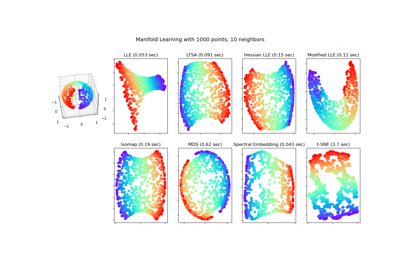SpectralEmbedding#
- class sklearn.manifold.SpectralEmbedding(n_components=2, *, affinity='nearest_neighbors', gamma=None, random_state=None, eigen_solver=None, eigen_tol='auto', n_neighbors=None, n_jobs=None)[source]#
Spectral embedding for non-linear dimensionality reduction.
Forms an affinity matrix given by the specified function and applies spectral decomposition to the corresponding graph laplacian. The resulting transformation is given by the value of the eigenvectors for each data point.
Note : Laplacian Eigenmaps is the actual algorithm implemented here.
Read more in the User Guide.
- Parameters:
- n_componentsint, default=2
The dimension of the projected subspace.
- affinity{‘nearest_neighbors’, ‘rbf’, ‘precomputed’, ‘precomputed_nearest_neighbors’} or callable, default=’nearest_neighbors’
- How to construct the affinity matrix.
‘nearest_neighbors’ : construct the affinity matrix by computing a graph of nearest neighbors.
‘rbf’ : construct the affinity matrix by computing a radial basis function (RBF) kernel.
‘precomputed’ : interpret
Xas a precomputed affinity matrix.‘precomputed_nearest_neighbors’ : interpret
Xas a sparse graph of precomputed nearest neighbors, and constructs the affinity matrix by selecting then_neighborsnearest neighbors.callable : use passed in function as affinity the function takes in data matrix (n_samples, n_features) and return affinity matrix (n_samples, n_samples).
- gammafloat, default=None
Kernel coefficient for rbf kernel. If None, gamma will be set to 1/n_features.
- random_stateint, RandomState instance or None, default=None
A pseudo random number generator used for the initialization of the lobpcg eigen vectors decomposition when
eigen_solver == 'amg', and for the K-Means initialization. Use an int to make the results deterministic across calls (See Glossary).Note
When using
eigen_solver == 'amg', it is necessary to also fix the global numpy seed withnp.random.seed(int)to get deterministic results. See pyamg/pyamg#139 for further information.- eigen_solver{‘arpack’, ‘lobpcg’, ‘amg’}, default=None
The eigenvalue decomposition strategy to use. AMG requires pyamg to be installed. It can be faster on very large, sparse problems. If None, then
'arpack'is used.- eigen_tolfloat, default=”auto”
Stopping criterion for eigendecomposition of the Laplacian matrix. If
eigen_tol="auto"then the passed tolerance will depend on theeigen_solver:If
eigen_solver="arpack", theneigen_tol=0.0;If
eigen_solver="lobpcg"oreigen_solver="amg", theneigen_tol=Nonewhich configures the underlyinglobpcgsolver to automatically resolve the value according to their heuristics. See,scipy.sparse.linalg.lobpcgfor details.
Note that when using
eigen_solver="lobpcg"oreigen_solver="amg"values oftol<1e-5may lead to convergence issues and should be avoided.Added in version 1.2.
- n_neighborsint, default=None
Number of nearest neighbors for nearest_neighbors graph building. If None, n_neighbors will be set to max(n_samples/10, 1).
- n_jobsint, default=None
The number of parallel jobs to run.
Nonemeans 1 unless in ajoblib.parallel_backendcontext.-1means using all processors. See Glossary for more details.
- Attributes:
- embedding_ndarray of shape (n_samples, n_components)
Spectral embedding of the training matrix.
- affinity_matrix_ndarray of shape (n_samples, n_samples)
Affinity_matrix constructed from samples or precomputed.
- n_features_in_int
Number of features seen during fit.
Added in version 0.24.
- feature_names_in_ndarray of shape (
n_features_in_,) Names of features seen during fit. Defined only when
Xhas feature names that are all strings.Added in version 1.0.
- n_neighbors_int
Number of nearest neighbors effectively used.
See also
IsomapNon-linear dimensionality reduction through Isometric Mapping.
References
On Spectral Clustering: Analysis and an algorithm, 2001 Andrew Y. Ng, Michael I. Jordan, Yair Weiss
Normalized cuts and image segmentation, 2000 Jianbo Shi, Jitendra Malik
Examples
>>> from sklearn.datasets import load_digits >>> from sklearn.manifold import SpectralEmbedding >>> X, _ = load_digits(return_X_y=True) >>> X.shape (1797, 64) >>> embedding = SpectralEmbedding(n_components=2) >>> X_transformed = embedding.fit_transform(X[:100]) >>> X_transformed.shape (100, 2)
- fit(X, y=None)[source]#
Fit the model from data in X.
- Parameters:
- X{array-like, sparse matrix} of shape (n_samples, n_features)
Training vector, where
n_samplesis the number of samples andn_featuresis the number of features.If affinity is “precomputed” X : {array-like, sparse matrix}, shape (n_samples, n_samples), Interpret X as precomputed adjacency graph computed from samples.
- yIgnored
Not used, present for API consistency by convention.
- Returns:
- selfobject
Returns the instance itself.
- fit_transform(X, y=None)[source]#
Fit the model from data in X and transform X.
- Parameters:
- X{array-like, sparse matrix} of shape (n_samples, n_features)
Training vector, where
n_samplesis the number of samples andn_featuresis the number of features.If affinity is “precomputed” X : {array-like, sparse matrix} of shape (n_samples, n_samples), Interpret X as precomputed adjacency graph computed from samples.
- yIgnored
Not used, present for API consistency by convention.
- Returns:
- X_newarray-like of shape (n_samples, n_components)
Spectral embedding of the training matrix.
- get_metadata_routing()[source]#
Get metadata routing of this object.
Please check User Guide on how the routing mechanism works.
- Returns:
- routingMetadataRequest
A
MetadataRequestencapsulating routing information.
- get_params(deep=True)[source]#
Get parameters for this estimator.
- Parameters:
- deepbool, default=True
If True, will return the parameters for this estimator and contained subobjects that are estimators.
- Returns:
- paramsdict
Parameter names mapped to their values.
- set_params(**params)[source]#
Set the parameters of this estimator.
The method works on simple estimators as well as on nested objects (such as
Pipeline). The latter have parameters of the form<component>__<parameter>so that it’s possible to update each component of a nested object.- Parameters:
- **paramsdict
Estimator parameters.
- Returns:
- selfestimator instance
Estimator instance.
Gallery examples#

Various Agglomerative Clustering on a 2D embedding of digits

Manifold learning on handwritten digits: Locally Linear Embedding, Isomap…

